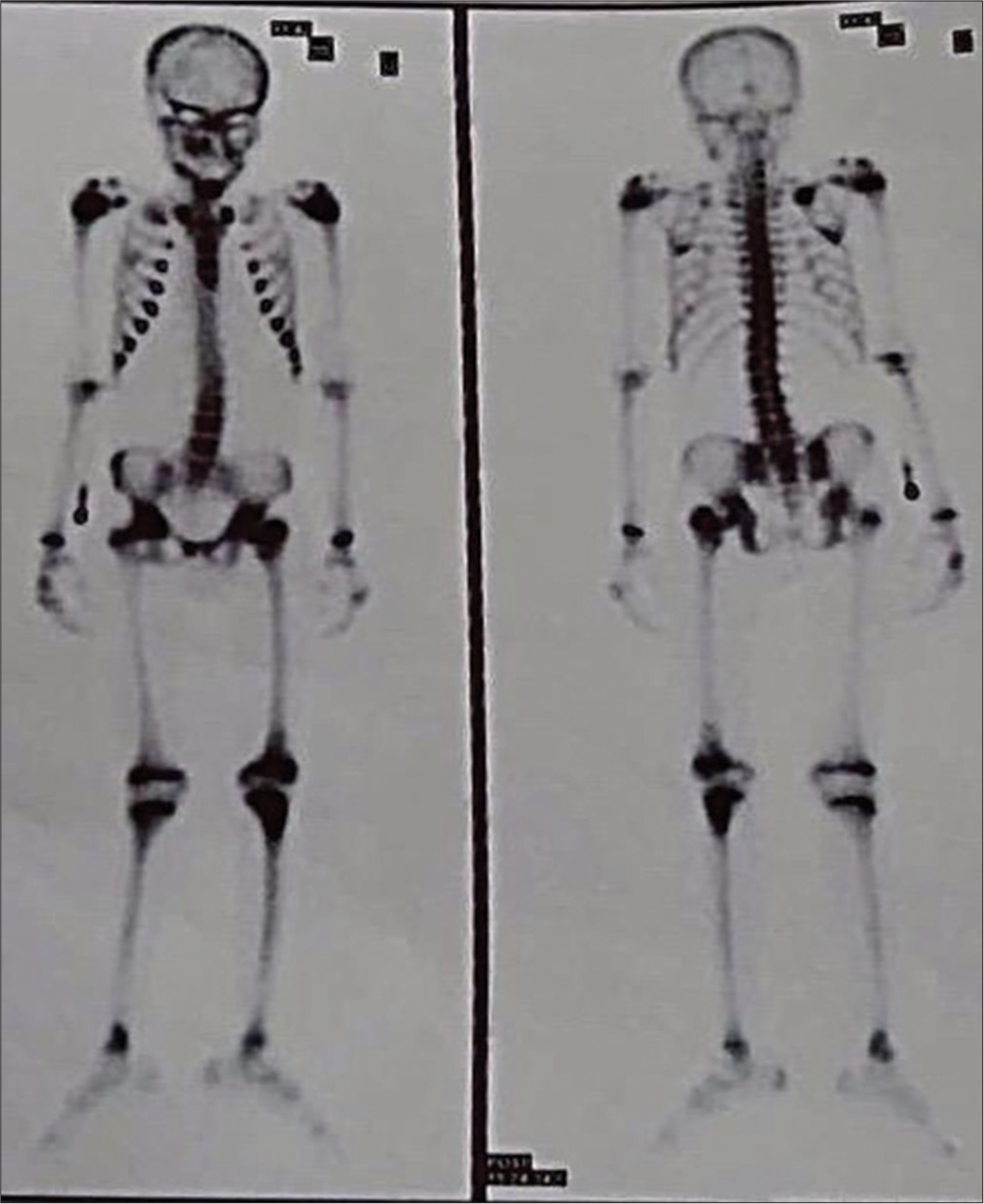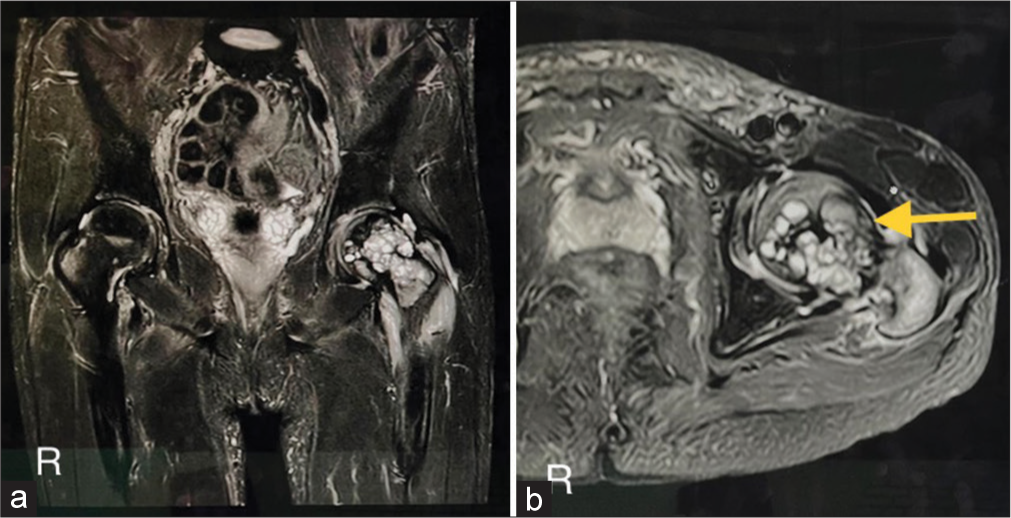Translate this page into:
Lytic lesions in bone in a CKD patient, brown tumor is a must on the differential
*Corresponding author: Norris Moses Rodrigues, Department of Pediatrics, Bai Jerbai Wadia Hospital for Children, Maharashtra, India. norrisrod12.9@gmail.com
-
Received: ,
Accepted: ,
How to cite this article: Rodrigues NM, Ohri A, Udani A, Shah C, Agrawal S. Lytic lesions in bone in a CKD patient, brown tumor is a must on the differential. Wadia J Women Child Health. 2023;2(3):132-5. doi: 10.25259/WJWCH_23_2023
Abstract
Brown tumor is a focal lesion of giant cells without neoplastic potential encountered in association with hyperparathyroidism. These lesions can occur anywhere in the skeletal system producing various local symptoms. In this case report, we present a 15-year-old boy with stage 5 chronic kidney disease (CKD) on maintenance hemodialysis who presented with hip pain for 1 week. On investigating, the patient had normal parathyroid levels (PTH) but the previous metabolic bone disorder (MBD) parameters revealed a high PTH. Imaging showed expansile radiolucent lesions involving the left hip. Considering the clinical, metabolic and the radiological picture the patient was diagnosed to have brown tumor with secondary hyperparathyroidism and was treated with Cinancalcet, vitamin D and immobilization with a brace.
Keywords
Mineral bone disorder
Calcimimetics
Hyperparathyroidism
INTRODUCTION
Brown tumors are focal bone lesions occurring in patients with uncontrolled hyperparathyroidism. (HPT).[1] They can be present in any part of the skeleton, but are generally encountered in the ribs, clavicles, extremities, and pelvic girdle.[2]
The elevated level of parathyroid hormone (PTH) causes osteoclastic resorption and fibroblastic proliferation of the bones due to its anabolic effect.[3] There is an imbalance between bone formation and resorption leading to bone lysis and subsequent formation of fibroelastic tissue that deforms the bone.[2,4] Ninety-two percent of the patients with chronic kidney disease (CKD) develop secondary HPT and among these patients around 1.5% develop brown tumors.[2,5] Here, we present a patient with CKD who presented with hip pain.
CASE REPORT
A fifteen-year-old male child, a case of CKD secondary to dense deposit disease, on regular maintenance hemodialysis for the past 6 years, now presented with left-sided hip pain and difficulty in ambulation for 1 week. Clinical examination was normal. There was no history of preceding trauma. There was no fever or any Koch’s contact. Preliminary laboratory parameters revealed a normal complete blood count and erythrocyte sedimentation rate ruling out infectious etiologies. Metabolic bone disorder (MBD) parameters revealed a normal PTH (126 mg/dL), normal calcium, alkaline phosphatase, and phosphorus.
Radiographs were suggestive of radiolucent lytic bone lesions in the left hip.
His MBD parameters over the past 2 years revealed that the child did have high PTH initially accompanied by high serum fibroblast growth factor 23 (FGF-23) levels [Table 1].
| Date (dd/mm/yy) | 8/6/20 | 3/2/21 | 3/12/21 | 4/3/22 | 30/9/22 |
|---|---|---|---|---|---|
| Serum 25 Hydroxy Vitamin D (N=30-100) (ng/dl) | 29 | 48 | 49 | 43 | 49 |
| iPTH (N=10-55) (pg/ml) | 1349 | 1163 | 1422 | 126 | 415 |
| Serum Ca (N=8.8-10.8) (mg/dl) | 8.8 | 8.7 | 9.0 | 8.2 | 8.9 |
| Serum Phosphorous (N= 3.3-5.6) (mg/dl) | 5.5 | 4.2 | 4.6 | ||
| Serum FGF23 (N = 0-150) (RU/ml) | 1707 | 1288 |
iPTH: intact Parathyroid hormone, FGF-23: Fibroblast growth factor 23, MBD: Metabolic bone disease, Ca: Calcium, N: Normal range
A whole-body bone scan with technetium 99m-methyl diphosphonate (99m-TC MDP) [Figure 1] revealed well-defined expansile lytic lesions involving multiple sites of the skeletal system. Diffuse sclerosis with rugger jersey appearance involving the entire spine was noted.

- Bone scan: Diffuse increase in tracer uptake noted in entire axial and appendicular skeletal system. Correlative SPECT/CT revealed well defined expansile lytic lesions involving following bones: On right side: 5th metacarpal, scapula, distal tibia, 4th metatarsal. On left side: Expansile lytic lesions are seen involving the lateral aspect of left clavicle, 1st metacarpal, roof of left acetabulum, proximal femur, lateral femoral condyle, proximal part of fibula, distal radial bone and proximal humerus.
Magnetic resonance imaging (MRI) of hip joint revealed diffuse hypointense T1 signal of the marrow of pelvic bones and hyperintense signals on T1 short tau inversion recovery (STIR). Multiple well-defined cystic areas in the left lesser trochanter, roof of the left acetabulum, the right superior pubic ramus, and anterior inferior iliac spine on the right side were observed. The largest lesion was seen in the head and neck of the left femur. These findings were suggestive of brown tumors with changes of renal osteodystrophy [Figure 2].

- (a) Diffuse hypointense T1 signal of marrow of pelvic bones and hyperintense T1 short tau inversion recovery (STIR). Multiple well defined cystic areas in the left lesser trochanter, roof of left acetabulum, right superior pubic ramus and in anterior inferior iliac spine on right side. Largest lesion is seen in the head and neck of left femur. These findings are suggestive of brown tumor with changes of renal osteodystrophy. (b) shows well defined lobulated expansile lesion with internal septations seen more prominently in the head and neck region (yellow arrow). Internal septations: thickening seen within lesions, suggesting non enhancing lines within the lesion.
Based on the child’s clinical history, clinical features, laboratory reports, and imaging findings, a diagnosis of brown tumor with secondary HPT was made.
Ultrasonography of the neck and sestamibi scan showed normal thyroid and parathyroid gland. The child was treated with Cinacalcet for 4 weeks, Vitamin D supplementation as per recommended dietary allowance (RDA) and maintenance hemodialysis along with brace and immobilization with periodic monitoring of serum calcium and phosphorus levels. The child showed a significant improvement in his symptoms.
DISCUSSION
CKD results in skeletal manifestations such as osteoporosis in adults and rickets in children due to HPT, collectively referred to as renal osteodystrophy.
HPT can be either due to primary, secondary, or tertiary causes. Primary HPT is caused by parathyroid adenoma (85% of cases), hyperplasia (15% of cases), or carcinoma (<1% of cases) and is characterized by hypercalcemia and hypophosphatemia. Secondary HPT can have multiple etiologies including CKD in majority of cases and few others like malnutrition, or Vitamin D deficiency. Contrary to primary HPT, it is characterized by decreased serum calcium and normal or increased serum phosphate. Tertiary HPT is characterized by hypercalcemia and hyperphosphatemia[1,6] [Table 2].
| Primary | Secondary | Tertiary | |
|---|---|---|---|
| PTH | High | High | High |
| Calcium | High | Low/Normal | High |
| Phosphorus | Low | High/Normal | High |
| Vitamin D | Normal/low | Low | Normal/Low |
PTH: Parathyroid hormone
Brown tumor, also known as cystic fibrous osteitis, is a rare metabolic bone disease that can develop in advanced stages of HPT with multifactorial etiopathogenesis.[3] The terminology brown tumor is derived from the dark red appearance seen in the lesion due to the bleeding and hemosiderin pigmentation.[2,5,7] The average course of the disease reported in the literature is 10 months, although it can range from as little as 1 month to longer periods like 3 years.[2,4,5]
Decreased renal function in CKD leads to phosphate retention. This triggers the release of FGF-23 from the osteocytes. FGF-23 reduces the production of 1,25-dihydroxy cholecalciferol, thus, stimulating the release of PTH.[3] Brown tumor though frequently observed in the pelvis, femur and the facial bones, can rarely occur in other parts of the skeleton.[3] These lesions can have various presentations such as pain, swelling, and/or pathological fracture.[2,5] Furthermore, the patient may present with features of secondary HPT classically referred to as bone, stone, abdominal groan, and psychic moan.[3]
Laboratory findings reveal various metabolic derangements suggesting CKD and HPT. Increased FGF-23 levels may be one of the earliest detectable biomarkers of CKDMBD.[2] FGF-23 concentration may be increased due to the abnormal stimulation of its secretion exerted by substances released from the damaged renal parenchyma, or by the effects exerted by the uremic state on bone mineralization processes. FGF-23 is the earliest indicator of alterations in mineral metabolism. FGF-23 assay may aid in the diagnosis and management of the patient with CKD-MBD in the early stages of the disease before the increase of the routinely used laboratory parameters, PTH, and Vitamin D which occur in more advanced stages of the disease.[6]
Brown tumor on microscopic examination demonstrates a highly vascular connective tissue with diffusely distributed multinucleated giant cells and areas of hemorrhage and hemosiderin deposits.[2] The correct diagnosis requires a correlation of the MBD parameters to clinical and imaging data.[2] The imaging profile typically reveals a well-demarcated radiolucent unilocular or multilocular osteolytic lesion. Furthermore, it may reveal root resorption or loss of lamina dura.[3]
Further workup with bone scintigraphy (99m-TC MDP) shows intense uptake by brown tumor and helps in localizing other areas of similar activity.[3]
In the spine alternating areas of hypo- and hyper-density are seen in the endplates of the vertebral body giving it a characteristic striped appearance, also known as the rugger-jersey spine.
Treatment of brown tumors is mainly pharmacological by correcting the underlying HPT with calcimimetics. Dialysis, parathyroidectomy, or kidney transplantation would help normalise the HPT levels. With the normalization of the PTH level, the tumor often regresses or resolves.[1] Surgical resection of a brown tumor is necessary if the bony lesion is compromising body functions or promoting facial deformation, or if the lesion fails to regress.[7,8] Some centers prefer curettage with wound packing, allowing for secondary healing, in addition to medical management.[3]
CONCLUSION
Improvement in dialysis and aggressive management of MBD in CKD has made brown tumor a rarity, yet any joint or limb pain in patients with CKD prompts a revisit to the MBD parameters, MRI, and bone scans to detect the presence of brown tumor in children. Although, our patient had normal PTH at presentation, a revisit to his previous MBD parameters revealed a high PTH. Furthermore, the patient had high FGF-23 which decreased post-treatment. Although biopsy is the gold standard of diagnosis of brown tumors, FGF-23 is the earliest indicator of alterations in mineral metabolism and is a useful parameter in early diagnosis and management of children with CKD-MBD.
Ethical approval
Institutional Review Board approval is not required.
Declaration of patient consent
Patient’s consent not required as the patients identity is not disclosed or compromised.
Conflicts of interest
Dr. Alpana Ohri is on the Editorial Board of the Journal.
Use of artificial intelligence (AI)-assisted technology for manuscript preparation
The authors confirm that there was no use of artificial intelligence (AI)-assisted technology for assisting in the writing or editing of the manuscript and no images were manipulated using AI.
Financial support and sponsorship
Nil.
References
- Brown tumors: A case report and review of the literature. Case Rep Nephrol Dial. 2016;6:46-52.
- [CrossRef] [PubMed] [Google Scholar]
- Brown tumor as a result of secondary hyperparathyroidism in chronic renal disease. J Oral Diagn. 2016;1:e20160021.
- [CrossRef] [Google Scholar]
- Chronic kidney disease presenting with brown tumors in the mandible. Cureus. 2022;14:e23985.
- [CrossRef] [Google Scholar]
- Unusual presentation of primary hyperparathyroidism: Report of three cases. BMC Med Imaging. 2015;15:23.
- [CrossRef] [PubMed] [Google Scholar]
- A rare complication of secondary hyperparathyroidism. Brown tumor of the maxilla and mandible. Saudi Med J. 2004;25:2010-2.
- [Google Scholar]
- Diagnostic utility of FGF-23 in mineral bone disorder during chronic kidney disease. J Circ Biomark. 2022;11:1-4.
- [CrossRef] [PubMed] [Google Scholar]
- Surgical approach and clinical outcome of a deforming brown tumor at the maxilla in a patient with secondary hyperparathyroidism due to chronic renal failure. Arq Bras Endocrinol Metabol. 2006;50:963-7.
- [CrossRef] [PubMed] [Google Scholar]
- Brown tumor of the maxillary sinus in a patient with primary hyperparathyroidism: A case report. J Med Case Rep. 2009;3:7495.
- [CrossRef] [PubMed] [Google Scholar]






